Battery Light Comes On Then Goes Off When Accelerating
While we travel, we often discover mysterious lights on our dashboard, especially the battery light. It indicates that your automobile’s electrical system isn’t doing well. It’s annoying while accelerating your car.
But why does the battery light come on and then go off when accelerating? The problems are associated with a weak battery, clogged alternator, damaged serpentine belt, and weak battery connection. You should get a new battery and check the connections, serpentine belt, and alternator. In severe circumstances, reach out to a mechanic. However, keep an eye out if the battery light stays on when you speed up or go slow.
Stay with me to know what are the reasons why light goes off during acceleration. I’ll discuss how to identify this problem and how to resolve the problem as well. Just keep on reading.
Battery Light Comes On Then Goes Off When Accelerating: Causes and Fixes
Let’s get to know the core possible reasons and their fixes in a nutshell.
| Causes | Possible Fixes |
|---|---|
| Weak or Aging Battery | Replace the battery. |
| Check and clean battery connections. | |
| Clogged Alternator | Consult a mechanic for alternator inspection. |
| Consider alternator replacement if necessary. | |
| Damaged Serpentine Belt | Inspect the serpentine belt for wear and tear. |
| Replace the serpentine belt if it’s damaged. | |
| Weak Battery Connections | Tighten and clean battery terminals and clamps. |
| Ensure proper connection and no corrosion. | |
| Replace corroded or damaged terminals. |
See, these are the possible causes and fixes. There might be other causes that potentially can cause the battery light to come on and then go off. I’ll try to come up with those problems as well. Let’s just get started with the elaborative discussion.
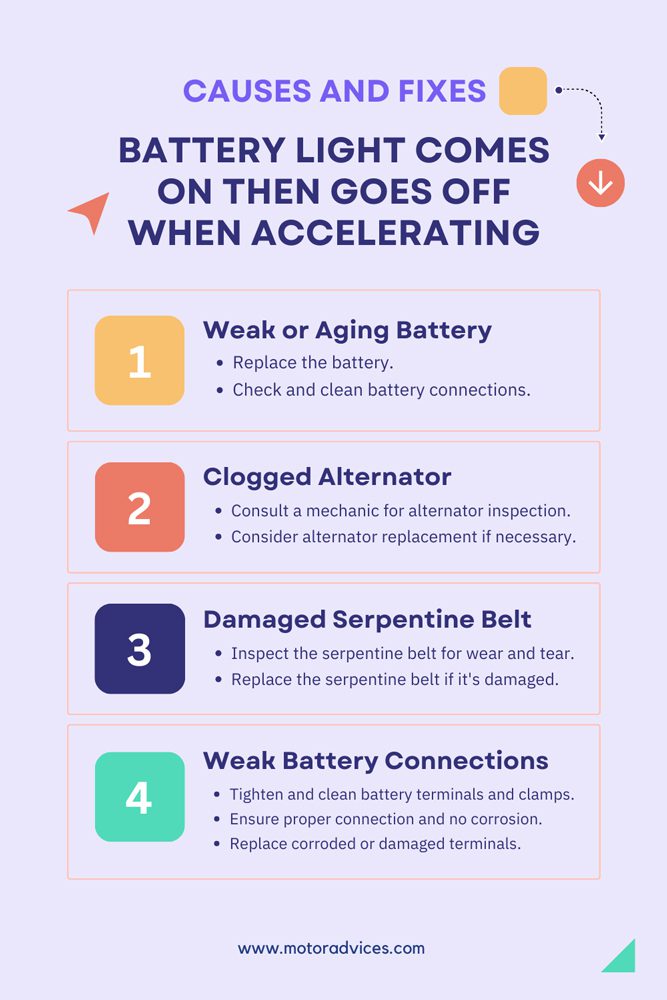
Cause 1: Weak or Aging Battery
A weak battery can be considered a prime reason for the battery light to come on and then go. Here’s how.
When you accelerate, your automobile engine requires more power to operate various components such as fuel injectors, ignition systems, and other associated electronic accessories. To meet the power requirement, the alternator has to generate more power. The alternator replenishes the battery’s charge in that process.
A weak battery also makes it challenging for the batteries. When the engine demands more electrical power during acceleration, the battery fails to provide capacity to the alternator, and voltage fluctuation occurs as a consequence. All these eventually trigger the battery light on your dashboard.
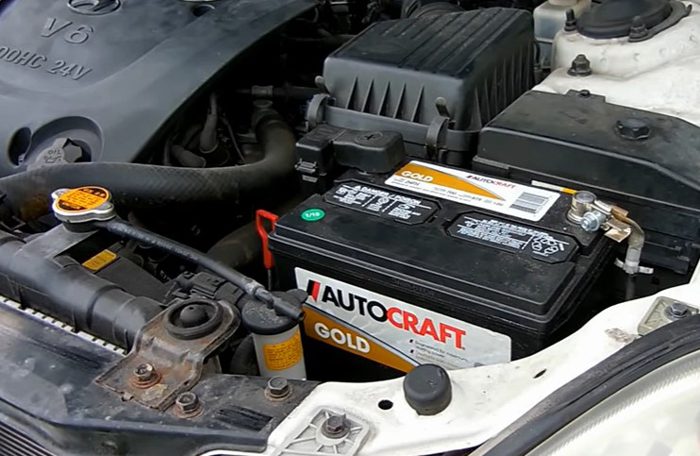
How to Identify?
See, this isn’t something I can tell specifically. But you may see the symptoms as follows:
- Battery age does matter. If your battery is more than 3 or 4 years old, please check your battery health. It is most likely to be weak if it’s been used for these mentioned time periods. The average life span of a car battery is three years, more or less.
- The car might struggle to start. An older battery struggles to provide power from the engine start.
- Electronic accessory malfunctions might occur, such as power windows or power locks.
How to Fix?
In this circumstance, the steps below might be handy.
- First, perform a voltage test. A healthy battery should show 12.6 voltage readings. If it’s lower, the battery is weak.
- Now, look for any visible damage. You can be looking for physical damage, leakage, or swelling. If you have seen so, the battery needs to be replaced.
- Now is the time to replace the battery. First, locate the battery. Depending on the car, the location may vary. However, follow the manufacturer’s manual to find out the location.
- Remove the old battery first. Disconnect the cables. The negative cable should be disconnected first, and then the positive cable. Carefully install the new battery. Make sure to connect the positive and negative terminals, respectively.
If you aren’t comfortable with doing all this stuff, I recommend contacting a technician. They’ll adequately sort out the problem and apply necessary solutions.
Now, how much is the cost? A car battery might cost around $200. In total, it can be around $300 in total to replace a battery.
Cause 2: Faulty Alternator
I guess the previous problem discussion has already covered a little about the alternator’s job in an automobile. A faulty alternator can trigger the battery light because of insufficient power. It basically occurs for the reasons below.
- Insufficient power generation
- Voltage regulation problems
- Alternator belt problems
Besides insufficient power generated by the alternator, it can slip if the alternator belt is damaged or worn out. This will make the alternator struggle to produce consistent power.
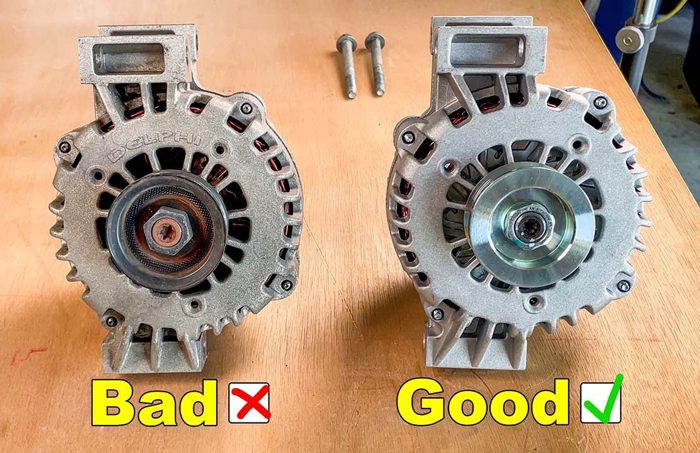
How to Identify?
Spotting a bad alternator as the cause of your battery light issue is crucial. Here’s how to check it.
- First, check the battery voltage. If the voltage reading is around 13, it’s in good condition. If not, then something is wrong.
- A malfunctioning alternator may also trigger a check engine light or battery warning lights.
- A grinding or whining noise is likely to be heard if the problem is with the alternator.
How to Fix?
Replacing the alternator can resolve the problem in that case. Follow the steps below:
- Step 1: Stop the car in a convenient location.
- Step 2: To avoid electrical accidents, unhook the negative battery cable.
- Step 3: You have to locate the serpentine belt that drives the alternator. To do so, release tension using the belt tensioner to take it off. Checking your car’s manual for specific information is suggested.
- Step 4: Now, locate the alternator and its bolts. Remove them to detach the alternator.
- Step 5: Out the new alternator, secure the mountaineering bolts, and reconnect the wires.
- Step 6: Carefully put the serpentine belt back on the pulleys.
- Step 7: Place the battery in place again.
You should successfully install a new alternator by following the steps above appropriately. Now, test the system by using a multimeter. You should look for a voltage of around 13V. However, if you’re uncertain about the replacement process, consult a mechanic to do this.
An alternator can cost approximately $400. If you can do it yourself, then that’s all about the cost. All in all, it might be up to $500, including the labor cost.
For a clearer visual, you may watch this video:
Cause 3: Serpentine Belt
The serpentine belt is like a power line in your car. While you’re accelerating, it’s these parts will need more power. An old or worn serpentine belt might slip on the alternator. Which eventually makes it hard to produce a smooth electricity flow.
This electricity fluctuation will cause the battery light to turn on and off.
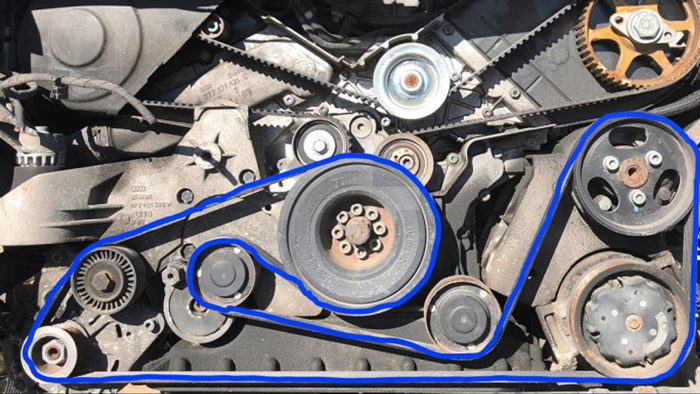
How to Identify?
To determine if the battery light issue is associated with a worn serpentine belt, you may look for these signs:
- A high-pitched squeal noise from the engine might be heard.
- Inspect the belt for cracks, fraying, or glazing. These are clear signs of wear and shouldn’t be ignored.
- If your power steering or air conditioning parts start acting up, it could be due to a failing serpentine belt.
- Check the tightness of the belt by pressing on it. It should provide some resistance. But remember that it will not be excessively tight or too loose.
How to Fix?
Replacing the old serpentine belt with a new one is the solution here. To do this, follow the steps below.
- Step 1: Park the car in a location that is convenient.
- Step 2: Look for any visible damage in the serpentine belt, such as cracks.
- Step 3: Now, locate the tensioner. The serpentine belt is kept under tension by a tensioner pulley. Use a suitable tool like a breaker bar or a wrench to release the tension on the old belt.
- Step 4: Slide the old serpentine belt off the pulley.
- Step 5: Now install a new belt. Follow the correct routing by threading the new belt onto the pulleys. Ensure it’s securely seated on each pulley.
- Step 6: Use a proper tensioner tool to apply the right amount of tension to the new belt. Refer to your vehicle’s manual for tension specifications.
- Step 7: Double-check that the belt is correctly aligned on all pulleys.
Now turn on the engine to check if the problem is solved. Try to listen to some unusual noises. If you don’t hear anything, go for a test drive, as your problem might be resolved.
If not, consult with a professional now. The costs may vary depending on the vehicle model, size, and some other things. Cost might be anywhere in between $200 – $500.
You may watch this video below, where a man is changing an old model Volkswagen serpentine belt.
Cause 4: Bad Battery Connection
If the battery terminals are dirty or not on tight, it can cause the battery light to go on and off, especially when you speed up your car. It happens because while the terminals or the connections aren’t alright, electricity moves create a mess. Let me explain why it happens.
Battery terminals, over time, can build up corrosion. Chemical reactions between the battery posts and the terminals typically cause this. This corrosion can create a barrier between the battery and the connecting cables and disturb the flow of electricity. Mainly, the connection failed to supply the required power while accelerating.
Loose battery terminals can be another common cause. When you speed up, the terminals can jiggle around and make the electrical connection come and go. The engine’s shaking can make the entire situation even worse.
While the engine gets faster, the loose terminals might lose touch with the battery posts, making the battery light come on.

How to Identify?
To identify whether the problem is actually with a bad battery connection, pop the hood to find the battery. Look for any physical damage like corrosion or greeny appearance.
Check if the battery terminals are all secured. They should be tight to move. If they move quickly, be sure there’s an issue.
How to Fix?
In this case, you have to disconnect the battery first. Here’s what you have to do next:
- Step 1: Clean the terminal using baking soda and water. Scrub away any corrosion with a wire brush until the metal surfaces are clean and shiny.
- Step 2: Check the battery cables for any damage or fraying. Replace them if they are in poor condition.
- Step 3: Now reconnect the battery. Apply a thin layer of terminal grease or petroleum jelly to the battery terminals.
- Step 4: Now check the voltage range. Use a voltmeter or multimeter to measure. Look if the read is in the normal range.
However, I have said it already, and I am saying it once again: a professional consultation is always a wise idea if you aren’t comfortable with fixing stuff.
How to Prevent This Problem?
Here’s a list of tips on how to prevent this battery light issue.
- Regularly inspect your battery connections for signs of corrosion or looseness.
- Clean your battery terminal using a terminal cleaner or homemade cleaner made with baking soda and water.
- Ensure the terminals are tightly connected to the battery posts.
- Inspect the battery cables in a timely manner, such as twice a week.
- Regularly check whether or not the battery’s health is in steady condition.
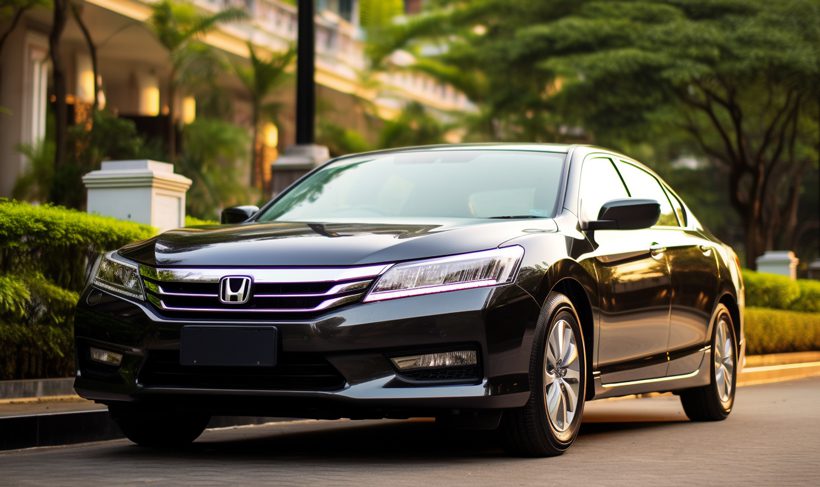
FAQs
Here are some additional things you might like to know.
Yes, it can potentially cause damage. While the light is illuminated, your battery doesn’t receive enough power from the alternator, and it uses its reserved power. If the battery is depleted, your car might stall.
Yes, extreme weather can, especially cold weather. Lithium-ion batteries usually can not receive the same charging current in cold and hot temperatures. It’s not enough when the weather is cold. Hence, your car battery light might come on.
Bottom Line
So, it’s a pretty typical scenario that during acceleration, the battery light comes on and then goes off. While you witness such an incident, immediately stop your car in a safe place and try to apply primary solutions such as battery and alternator checkups.
However, follow necessary preventative measures such as checking the battery health, cleaning the battery terminals, and checking the wirings. Taking such preventative measures will keep your automobile in steady health. And this will eventually give you a hassle-free, comfortable ride.


